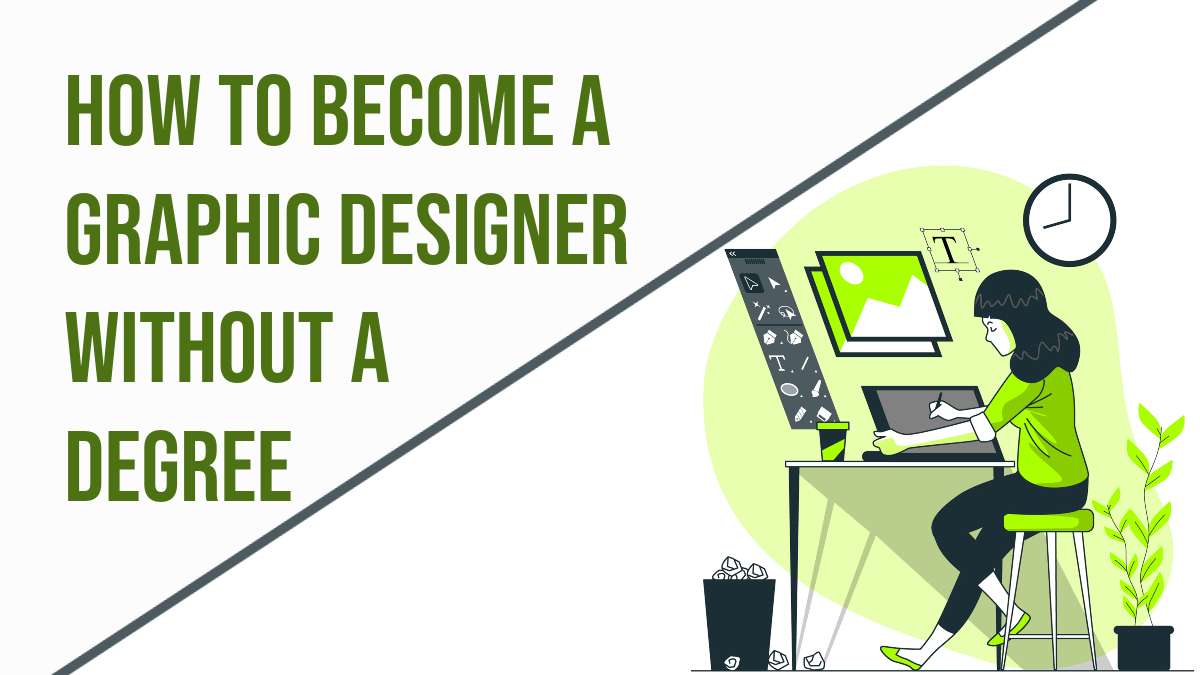
Especially, a job in graphic design might be ideal for you if you’re creative.
While obtaining a degree is one of the most frequent paths to becoming a graphic designer, it is far from the only one. So, if you’re waiting for a way to become a graphic designer without a degree, keep reading!
A degree is time-consuming and expensive, and it isn’t the best option for everyone. But don’t despair: there are alternative options for getting into graphic design without a degree. If you’re well prepared to put in the work, you can become a self-taught graphic designer.
This article will provide you with the necessary information about how to become a graphic designer without a degree?
Also, you can able to know,
Take the Time to Hone your Skills
Graphic design is a wide field with numerous specialties. A graphic design degree may provide you with a solid theoretical basis in many of these fields, but you can also specialize in a particular specialization or expertise without one.
Knowing a skill set better might provide you an edge when looking for employment. Logo design is constantly in demand and fits people who appreciate consumer communication theory.
Mobile apps and website design are two more domains where a specialty might help you succeed if you prefer technology to paper.
Attending local hackathons or startup events is a terrific way to get significant industry experience.
Learn to use the Software
To finish projects, graphic artists often use specialist free digital art software. It’s essential to download and acquaint yourself with Adobe Photoshop and Illustrator applications. Consider spending some time once you’ve downloaded this program to go through the Adobe tutorial.
Consider buying books and starting guides for Photoshop and Illustrator to get more in-depth instruction on their features. This information may assist you in effectively navigating the software required to perform your obligations as a graphic designer.
When you are applying for a career as a graphic designer, you should also mention your expertise using Photoshop and Illustrator on your CV.
This material may be used to demonstrate your competence in this industry and assure hiring managers or customers that you have the essential expertise and knowledge to succeed.
Invest in the Tools
Regardless of whether you pursue a degree in graphic design or not, your computer and software will be two of the most significant components of your professional graphic design job.
Software like Photoshop may place a great demand on an operating system’s speed and storage capacity, so it’s a smart impression to invest in a computer that’s up to date.
The most difficult decision to make is purchasing a PC or a Mac. Mac is the most popular operating system among professionals and creative organizations, but the decision to acquire a Mac ultimately boils down to personal preference and money.
Read more: How to Become an Investor
Find out How to Write
This may seem off-topic, but a designer’s work entails much more than just taking care of the photographs and making things look visually pleasing.
As well as being talented in design, a great copywriter will grasp the importance of the relationship between images, colors, and text to create an effective design.
Make use of the many online blogs and conventional design books devoted to design writing, and then try replacing the ‘Lorem Ipsum’ wording in your future design drafts with something more creative and effective.
Discover your Unique Design Style
You may possess every talent and certification available. Also, you won’t stand out from the crowd if you have a distinct and eye-catching style. That’s why it’s so important to devote some time to figuring out your style.
It’s what makes people remember you, seek you out, and want to hear from you again.
The process of developing your design style will take time. You’ll have to put in some effort and practice, practice, practice.
You might begin by looking at other designers’ work and determining what appeals to you the most. You may then utilize these pieces to inspire your endeavors, giving them your personal touch.
When you are deciding on a style, it is better to consider what you’re excellent at and what you like producing.
However, keep in mind what works effectively for the sorts of companies you wish to deal with. You’ll guarantee that your style appeals to the correct individuals and gets you employed this way!
Create a Portfolio
After you’ve learned how to use Adobe Illustrator and Photoshop and have a basic foundation of design philosophy, you can start building your portfolio.
A portfolio is an essential promotional tool for graphic designers since it showcases your skills and distinctive design viewpoint.
It’s a good idea to build a sample portfolio or mock designs before you start working with customers or looking for full-time work as a graphic designer.
Consider adding logos, web pages, decorative images, promotional flyers, brochures, or sophisticated typography to your portfolio to test your creativity. There are a variety of online portfolio providers to choose from; do some research and choose the one that best fits your demands.
Get to Grips with User Experience
Developing something that is both aesthetically attractive and practical is referred to as user experience in design.
Web pages, for example, must appear not only attractive but also be straightforward to browse from the user’s standpoint. You may improve your graphic design skills by learning the fundamentals of user experience.
Read more: How to Become a Tax Lawyer
Learn the Business of Design
Graphic design is a creative career, yet it functions in a commercial setting, as do other occupations. That implies you may bring talents to a job in the business that isn’t included in a degree program’s theoretical or practical lessons.
Client negotiations, designing to briefs, drafting business development proposals, and knowing how design work is priced, time is recorded, and the aspects that go into design contracts are all skills that are useful to have.
Reading design blog articles and keeping up with the latest advice for professionals that work with clients artistically may teach you a lot.
Learn about Gesign Theory
It’s critical to master the fundamentals of design theory before pursuing a career as a graphic designer. Design theory is a set of concepts and methods that explains why certain design aspects are more successful than others.
Understanding design theory may assist you in being more precise in your attempts to express brand message via your designs visually.
To learn about design theory, try studying online courses and learning sites.
Many of these services are available for free digital art courses or at a low cost via various websites and online education groups.
Local courses and short-term art or design programs in your town may also be helpful.
In-person learning is a fantastic method to learn from a professional teacher while also meeting individuals interested in pursuing a design career.
Make your Services Promote
Consider developing a professional website to sell your services once you’ve compiled an attractive portfolio. A professional website may be a great way to promote yourself while showcasing your graphic design abilities.
Make sure to include aspects of your graphic design philosophy into the design of your website. It’s critical to provide the following information on your website’s pages:
# Include your contact information for prospective clients and hiring managers to contact you.
# As a graphic designer, what has been your experience, philosophy, and point of view?
# A link to your work portfolio on the internet
It’s also the best idea to print and bring business cards with you to pitch your services to prospective customers and hiring managers.
Grab the Employment
You may start looking for employment as a graphic designer after equipping yourself with a portfolio and a good website. Make sure your CV shows your abilities and includes relevant creative or design roles.
Writing a cover letter that conveys your passion in the area and the work you’ve done to build your abilities and talents as a graphic designer may also be advantageous.
By looking for opportunities on online job-hunting portals, you may apply for entry-level, part-time, or contract work.
Your customer base is likely to grow as you take on additional tasks. Clients pleased with your work may refer you to others who need your services.
It’s critical to keep in touch with your clients and provide exceptional customer service to create and maintain favorable connections.
Read more: How to Become a Substitute Teacher Without Degree
Conclusion
Is a Graphic Designer Required to Have a Degree? The quick answer is no, and a degree is not required to be a successful graphic designer. Also, a degree may be required for certain positions or organizations.
However, even if you lack official degrees, several options are available. A degree isn’t the most crucial factor when it comes to landing a graphic design job.
Your experience, inventiveness, and skill level are all more crucial. A portfolio is just as important (if not more important) than a graphic design degree. You will have no issue being employed if you can demonstrate that you are talented and hardworking.
Graphic design is a good alternative if you seek creative professions that don’t need a degree. Incredibly, this is particularly true if you’re searching for entry-level positions.]
Or maybe you want to establish your own graphic design company? Then you probably don’t want to go to school for 3-4 years to get an expensive degree.
Instead, you may dive right in, enroll in some classes, and begin making money in a fraction of the time.










